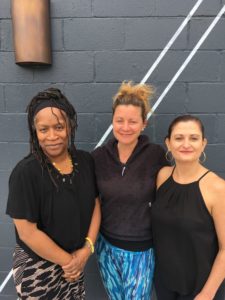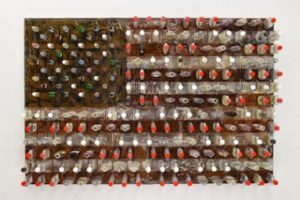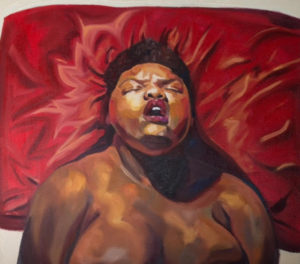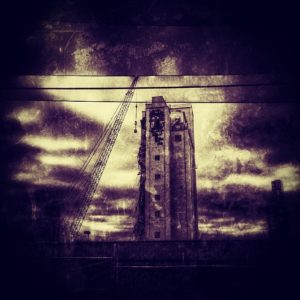
Don’t call 1619 Flux an art gallery. Certainly, it does show work in a gallery format; and it does sell work, but 1619 Flux is so much more.
Their mission is “to unify diverse people through creative expression as a catalyst for social change.” It is this distinction that separates them from most gallery spaces. 1619 exists to act as a conduit for people to connect through creative expression. Art is a part of that.
Kara Nichols created the concept to address the divisions she saw in the city. Despite Louisville being a diverse place to live, divisions due to class, race, and geography were stark. After having lived around the country, Nichols didn’t want her hometown to suffer because of these divisions. She also wanted the Portland neighborhood where her space exists to come alive again. So revitalization is a big part of 1619 Flux’s attention.

Planting the Seeds
Nichols thought a great way to address this issue was through art and creative expression. She hopes to “show emerging and established visual artists side-by-side and offer established community leaders and citizens the chance to engage in dialogue about crucial social issues to help integrate diverse groups.”
From there the seeds of 1619 Flux were planted. Nichols soon teamed up with Artistic Director Jesse Levesque, who was working at the time on the Be Kind festival. Together they began growing the mission of 1619 Flux.
Nichols began searching for space and found the perfect spot in 1619 Main St. “The building was used for storage and owned by Bryan Holden, who has had his artist studio next door for about 20 years and has lived there with his family for 10-plus years,” says Nichols. “It was just a shell with almost no windows, no plumbing, etc. and was transformed over about six months to the space you see now. It was a collaborative effort between me, WORK Architecture + Design and Marion Development.”

A Vision Becomes a Reality
The transformation of the space and developing the vision took dedication but also the help of investors who could help Nichols realize her vision.
“We had an investor who believed very strongly in the importance of our mission and provided the finances up front to build the space and help us sustain our non-profit for the first two to three years,” she says.
Once the building was complete the team began to expand. They first added local mixed media artist and activist Gwendolyn Kelly as the Community Outreach Director to help foster some of the internal programs and draw the community into 1619.
As Nichols focused on fundraising and bringing together new people to help with the mission, Levesque focused on the creative aspects of the gallery shows and connecting with people in the neighborhood.

Reaching the Neighbors
When they held their first show last April, they noticed that the diversity they were hoping for didn’t manifest.
“The event was different. At the first event, we were hoping to get a diverse group from all over the city. It was not the diversity we had hoped,” says Nichols. “So, we met a lot of people just walking around the community, and we asked ‘Why didn’t you come?’ They said, “It was all white people and they didn’t feel welcome.’”
This was not what Nichols or Levesque wanted to hear but knowing how the neighborhood felt clarified their mission and increased their focus on bringing the people from the neighborhood into 1619. The next event fared better.
“We did it very different in the ways that we reached out to the community, and we really got a diverse group of people,” Nichols says. “We have a map with pens where people mark their neighborhoods. So we know we got a diverse group. We did a lot of outreach. It was more of what I had hoped.”
However, some folks were still confused about the mission and have approached the team about hosting events that don’t fit necessarily with the 1619 Flux mission.
“We were bombarded with people wanting to do things. I think people thought we were a community center. We’re trying to be a space for people, but it has to be consistent with our mission,” Nichols says.
Levesque adds, “So that we can launch some of the internal programming around social change that works in tandem with the exhibitions, we had to start protecting the calendar. We have to have a certain amount of our own events.”

Connecting Conversations
One of their highly attended and engaging events is the Connecting Conversations series. Each session is a topical conversation-based event that works in tandem with the art on the walls. The themes from the art become springboards for deeper discussion. Gwen Kelly leads and opens each one with some food for thought and an agenda to set the tone of the evening. The popularity of these events grew quickly.
“We see the effects in the before and after of the events,” says Kelly. “We’ve had two speakers who requested to be on the program because they were inspired by previous conversations to think deeper about their role in community building. They wanted to share their epiphanies with others.”
During each Conversation, both the speakers and the audience are encouraged to share dialogue with each other and to leave feedback with 1619.
Past Connecting Conversations discussions included topics such as History of Neighborhoods & Race Relations, Making Strong City Wide Connections, Volunteering for Impact, and Speaking for the Public Good. Speakers ranged from nonprofit directors, photographers, community activists, and government and corporate employees.
“The Connecting Conversations gatherings will start focusing more directly on what everyday citizens can do to aid the revitalization of neighborhoods across Louisville,” says Kelly. “In addition to the open-to-all conversations with speakers, we will host work groups of citizens who are working directly to address some element of neighborhood revitalization.”

A Big Mission Ahead
The 1619 Flux team has a big mission ahead. They expanded their team even further to include Charles Booker as Development Director and Josh Ison as Marketing and Operations Director.
Nichols hopes this will solidify and strengthen the mission of 1619 Flux. She and her team want to be sure that when anyone leaves their space, they take some very important ideas with them.
“Everyone has a unique way of expressing themselves, making their voices heard. All voices are equally important and necessary regardless of class, race, etc. to bring about the social changes we need to sustain a thriving and healthy community. We want to serve as a community platform to guide this process,” she says.
Kelly agrees, “Every one of us needs to become a curious citizen and find out what is happening in the city—why it’s happening, how it’s happening, and help ensure that more of what’s happening is leading us to become a better, more inclusive Louisville.”
Louisville is a diverse place and to help that continue and to grow, we have to be curious about our neighbors and our neighborhoods. It is integral that citizens be informed and inquisitive about what is happening around them. The 1619 Flux team is committed to keeping those curiosity fires burning.


